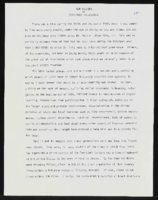Search the Special Collections and Archives Portal
Search Results
Astrid Silva oral history interview
Identifier
Abstract
Oral history interview with Astrid Silva conducted by Monserrath Hernández and Barbara Tabach on April 22, 2019 for the Latinx Voices of Southern Nevada Oral History Project. Astrid Silva was born in Gomez Palacio, Durango in 1988. She immigrated with her mother to the United States in 1992, where they were met by her father before flying to Los Angeles. She recounts her first impression of the United States and her families eventual move to Las Vegas, where she describes her time living in Las Vegas’ west side and struggles she faced being an undocumented student living in Las Vegas. She describes her first meeting with Senator Harry Reid and the friendship that developed afterwards. She has spoken at the Democratic National Convention and has been vocal about her status as a Dreamer. She is currently the Executive Director for DREAM Big Nevada which was established in 2017 in order to provide aid to Nevada’s immigrant families. She writes about her hopes for Dreamers and her continued work in expanding the ways that immigrant families can be helped in an always changing political climate. Subjects discussed include: DACA, Dreamers, Immigrant Rights, and Higher Education.
Archival Collection

"Our History": article draft by Roosevelt Fitzgerald
Date
Archival Collection
Description
From the Roosevelt Fitzgerald Professional Papers (MS-01082) -- Drafts for the Las Vegas Sentinel Voice file. On the need for more Black history courses.
Text
Roberta Kane oral history interview
Identifier
Abstract
Oral history interview with Roberta Kane conducted by Barbara Tabach on September 6, 2017 and May 22, 2018 for the Southern Nevada Jewish Heritage Project. Kane explains how she was the first born Jewish baby in Las Vegas, Nevada and her parents’ deep involvement with the Jewish community of the 1930s. She then talks about the formalization that occurred in the Jewish community with the building of Temple Beth Sholom. In a second session, Kane recalls the Wildcat Lair, a gathering spot of students from Las Vegas High School in the 1950s.
Archival Collection
Gloria Dea Anzalone oral history interview
Identifier
Abstract
Oral history interview with Gloria Dea Anzalone conducted by Claytee D. White on October 22, 2022 for the Boyer Early Las Vegas Oral History Project. In this interview, Gloria Dea describes her childhood in Oakland, California where she learned the art of magic from her father. Her family moved to Sacramento where Gloria Dea first performed in Breuners Department Store and by age twelve, she was working in nighclubs. Later in Hollywood, Gloria Dea danced in several films and entertained in USO shows. She performed in 1941 at the Last Frontier and the El Rancho - some of the earliest places on what was later the Las Vegas Strip. In the interview, she recalls time serving as president of both the Women's Club of Burbank, Hadassah, and the board of American Guild of Variery Artists.
Archival Collection

J. K. Russ oral history interview: transcript
Date
Archival Collection
Description
Oral history interview with J. K. Russ conducted by Claytee D. White on December 22, 2017 for the Remembering 1 October Oral History Project. In this interview, Russ discusses her early life in New Zealand and growing up on a tobacco farm. She remembers arriving to the United States and establishing a career as an artist. Russ talks about the 1 October shooting, creating an art exhibit using cards and letters received from people all over the world, and Las Vegas’ response to the tragedy. Lastly, Russ describes the art community in Las Vegas and the Arts District.
Text
John Hardie Moss Jr. oral history interview
Identifier
Abstract
Oral history interview with John Hardie Moss Jr. conducted by Phyllis Sherwin on February 22, 1981 for the Ralph Roske Oral History Project on Early Las Vegas. In this interview, Moss discusses his career as a world-class poker player and professional gambler in Las Vegas, Nevada. Moss describes the intricacies of poker and gambling, gambling for high-stakes, and cheating in the gambling world.
Archival Collection
Victoria and Brad Babich oral history interview
Identifier
Abstract
Oral history interview with Victoria and Brad Babich conducted by Claytee D. White on November 22, 2013 for the Boyer Early Las Vegas Oral History Project. In this interview, the Babich couple describe their family histories and life in Las Vegas, Nevada during the mid-twentieth century. Brad Babich discusses his father's work in the gaming industry of Las Vegas, the prevalence of organized crime in the city, the influence of Howard Hughes and the federal government, and other aspects of Las Vegas history. He also talks about nuclear weapons tests at the Nevada Test Site and the health problems some employees acquired there. The two talk about recreational activities of the time, as well as the entertainers that performed on the Las Vegas Strip. Other topics of discussion include race relations in Las Vegas, casino history, and changes that have occurred over the years in the city.
Archival Collection
Maxine and Jack Cason oral history interview
Identifier
Abstract
Oral history interview with Maxine and Jack Cason conducted by Claytee D. White and Stefani Evans on September 22, 1016 for the Building Las Vegas Oral History Project. In this interview, Jack discusses his early life in Oklahoma and arriving to Las Vegas, Nevada in 1950. He recalls the formation of Saveway Super Service, Philips 66 service stations, the competition in the fuel industry, and the opening of the first Rebel service station. Jack talks about fuel terminals, fuel bulk plants, and becoming one of the largest fuel providers in southern Nevada. Later, Maxine and Jack talk about supporting local sports organizations. Lastly, Jack discusses his involvement in the University of Nevada Las Vegas (UNLV) Athletics Department, and being inducted into the UNLV Sports Hall of Fame.
Archival Collection
Norma and Gil Schwartz oral history interview
Identifier
Abstract
Oral history interview with Norma and Gil Schwartz conducted by Stefani Evans and Claytee White on September 22, 2017, October 04, 2017, and February 14, 2018 for the Building Las Vegas Oral History Project. In the three interviews, the couple describes Gil’s leadership in the National Association of Real Estate Brokers (NAREB), properties that he’s built and developed, and purchasing blueprints of un(der)developed parcels in Las Vegas, Nevada on behalf of Howard Hughes's land agent, J. Herbert Nall.
Archival Collection
Su Kim Chung oral history interview
Identifier
Abstract
Oral history interview with Su Kim Chung conducted by Claytee White on March 11, 2021 for the Boyer Early Las Vegas Oral History Project.
Su Kim Chung is the Public Services Department Head of University of Nevada, Las Vegas Lied Library's Special Collections and Archives. This interview was conducted in part for the 20th year celebration of Lied Library. Su Kim first talks about the construction of Lied Library and what makes it special compared to the previous library building on campus. She then discusses her personal history and education that led her to UNLV, where she has now worked for 22 years. Her work involves manuscript curation, panel discussions with Las Vegas entertainers, and oral history collection among other activities. She has also written a book, Las Vegas Then and Now, that talks of the city's rich entertainment history.
Archival Collection
